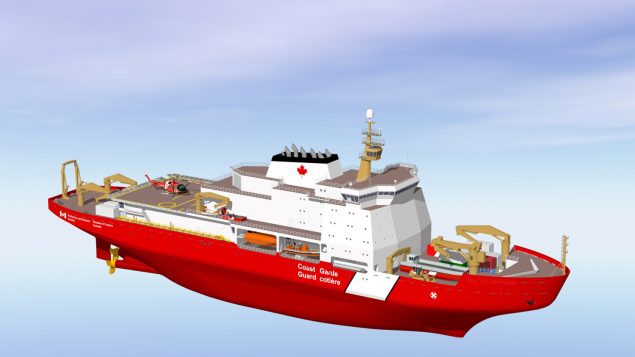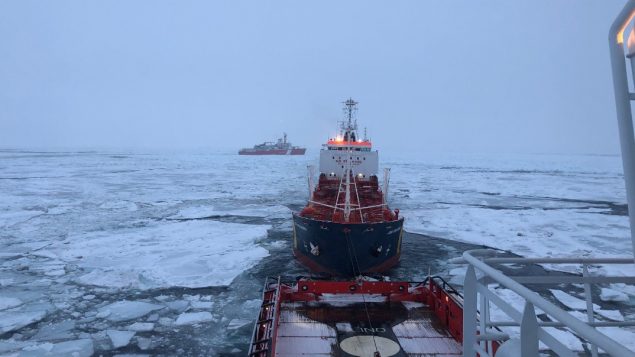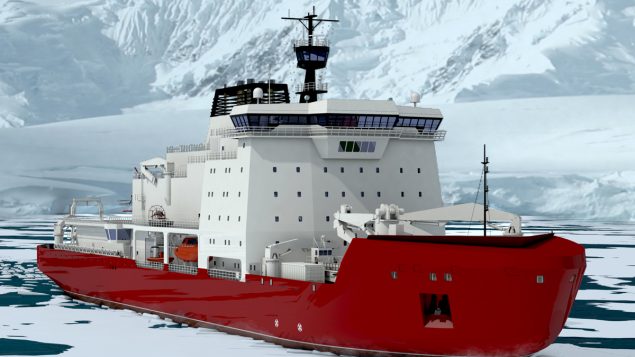The federal government is moving ahead with building two heavy icebreakers for the Canadian Coast Guard operations in the High Arctic, federal officials announced Thursday.
The 150-metre-long vessels will be able to operate in heavy ice conditions for up to nine months at a time as well carrying out important science research in the High Arctic.
Having two heavy icebreakers in its fleet will allow the Canadian Coast Guard to maintain a year-around presence in the Arctic, said Coast Guard Commissioner Mario Pelletier.
Canada’s Coast Guard fields the world’s second largest icebreaking fleet with 18 icebreakers of varying sizes and capability. Russia is the leading icebreaking power with 40 operational vessels, including 27 ocean-going icebreakers and plans to build 11 new ships.
‘A game-changer’
“The new Polar icebreakers will be a game-changer for Canada’s marine industry–both in their construction and the difference that a stronger presence in the Arctic will make,” said Fisheries Minister Bernadette Jordan, who is responsible for the Canadian Coast Guard.
The vessels will be built by two competing Canadian shipyards: Davie Shipbuilding in Quebec and Seaspan Shipyards in British Columbia, on Canada’s Pacific Coast. They are expected to be delivered a few months apart in 2030.
The government estimates that the construction of these ships will generate approximately 300 jobs per vessel at each shipyard, and 2,500 jobs across the Canadian marine industry, Jordan said.
But at virtual press conference on Thursday, officials were mum on the final cost of the project, adding that they will release the figures once the contracts with both shipyards are signed.

These new Polar icebreakers will be the largest ships in the Coast Guard fleet, with each ship having the following expected specifications: 150 meters in length; a beam of 28 meters; a top speed of approximately 18+ knots; accommodation for up to 100 crew and personnel; and a range of approximately 30,000 nautical miles. (Submitted Canadian Coast Guard)
The construction of these new ships is in addition to the $17.49 billion in contracts already awarded to shipyards across Canada under the National Shipbuilding Strategy (NSS) to build new vessels for the Royal Canadian Navy and the Canadian Coast Guard.
In May of 2019, Prime Minister Justin Trudeau announced plans to completely renew the coast guard’s ageing fleet and provide it with 18 new ships – 16 built by Seaspan’s Vancouver Shipyards and two civilian versions of the navy’s Arctic and Offshore Patrol Ship (AOPS) built by Irving Shipbuilding in Halifax.
Davie Shipbuilding, which went through a rough business patch several years ago, was left out of the original NSS but the company’s fortunes have markedly improved in recent years and it’s been lobbying hard to become the third major shipyard for the lucrative shipbuilding contracts under the NSS.
The company is expected to complete the qualification process in late 2021.
Need for two icebreakers in the Arctic

Canadian Coast Guard icebreaker CCGS Captain Molly Kool tows tanker Jana Desgagnes in Cabot Strait. In the background the CCGS Louis S St-Laurent is assisting with the difficult ice conditions by breaking a large field of ice so that the vessels can manoeuvre. (Photo courtesy of the Canadian Coast Guard)
For years, Ottawa was planning to build a single polar icebreaker to replace its ageing heavy icebreaker CCGS Louis S. St-Laurent, built in 1969.
But the recent growth in commercial shipping, the serious impacts of climate change, and increased maritime activity in the Arctic convinced the federal government that it needed at least two heavy icebreakers to ensure year-around coast guard presence in the Canadian Arctic, officials said.
“Perhaps the most noteworthy part of the government’s justification for having two Polars is the open recognition that they see a need for year-round presence in the Arctic,” said Timothy Choi, a maritime strategy expert at the University of Calgary’s Centre for Military, Security and Strategic Studies.
Until now, experts expected that the new heavy icebreaker will operate following the same pattern as the venerable Louis S. St-Laurent, which spends most of the year in the Arctic but goes for maintenance in the south during the worst of the winter season, Choi said.
Having two Polar-class icebreakers solves the maintenance issue by allowing one ship to be present in the North while the other is undergoing maintenance, enabling year-round presence in the Arctic, Choi said.
“While winter sea traffic in the Canadian Arctic is nearly non-existent, having the ability to operate in the North allows important science missions to be carried out that, until now, would not have been possible,” Choi said.
“Northern communities would also have greater flexibility and reliability for the delivery of their goods and cargo, which may help drive down the current enormous cost of living.”
Building a second polar icebreaker will also allow the Coast Guard to replace CCGS Terry Fox built in the 1980s, he added.
“So there is a real need for more than just one polar icebreaker for Canada, and this announcement is a major step in the right direction,” Choi said.

The Coast Guard icebreaker Terry Fox sits in the waters of Lancaster Sound, Nunavut at the eastern gates of the Northwest Passage in August 2006. (Bob Weber/THE CANADIAN PRESS)
‘An excellent opportunity’
By promising two heavy icebreakers and splitting the work, the government also avoids the political consequences of having to decide between competing shipyards in vote-rich B.C. and Quebec in what could be an election year.
David Perry is the vice president of the Canadian Global Affairs Institute. He said he found the government’s decision to build the two icebreakers in two different shipyards on the opposite ends of the country a bit surprising.
“I don’t think that’s going to be the most efficient way that we go about spending the money to build them,” Perry said. “This is the first time I can think of where a big government program has been announced and the government doesn’t discuss the cost at all.”
It’s also unclear whether the government plans to build two identical ships or whether each shipyard will build a slightly different version, he added.
Having slightly different systems on both ships could add up to the complexity of maintaining the vessels and eventually drive up the cost, Perry said.
Colin Cooke, president & CEO of the Canadian Marine Industries and Shipbuilding Association, welcomed the announcement and said it was good news not only for the two shipyards but for the entire marine sector in Canada.
“These are important ships for our country but also for our industry,” Cooke said. “They are an excellent opportunity to showcase the breadth and depth of Canadian expertise in ship construction and especially with regard to icebreakers.”







For reasons beyond our control, and for an undetermined period of time, our comment section is now closed. However, our social networks remain open to your contributions.